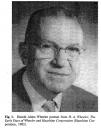FEBRUARY 2011 HISTORY
Scanning the Past: A History of Electrical Engineering from the Past
Submitted by Marc Bell, Editor
Copyright 1997 IEEE. Reprinted with permission from the IEEE publication, “Scanning the Past” which covers a reprint of an article appearing in the Proceedings of the IEEE Vol. 85, No. 1, January 1997.
Harold A. Wheeler: A Pioneer in Radio and Television

Fifty-five years ago this month, the PROCEEDINGS OF THE RADIO ENGINEERS (IRE) included a paper on interference between frequency-modulated signals by Harold A. Wheeler (see Fig. 1). Remembered as the inventor of a much used automatic volume control (AVC) circuit and numerous other technical contributions to communi¬cations engineering, he was a frequent contributor to the PROCEEDINGS during a professional career that spanned much of the 20th century. He served many years as a member of the IRE Board of Editors and was awarded the IEEE Medal of Honor in 1964.
Wheeler was born in 1905 in Minnesota where his father was an agricultural teacher. The family soon moved to South Dakota where his father taught for four years at South Dakota State College in Brookings. From 1907 to 1916, the Wheeler family lived in Mitchell, SD, where his father worked as manager of a seed company. Wheeler remembered Mitchell as having been “a small town with Hazeltine, inventor of the neutrodyne radio receiver and a professor at the Stevens Institute of Technology. Wheeler worked for Hazeltine during the summer of 1923 and came to regard Hazeltine as his principal mentor. Wheeler continued his formal education at Johns Hopkins University from 1925 to 1928 while continuing to work part time for the Hazeltine Company, founded in 1924 to manage patents and assist licensees. While at Johns Hopkins, Wheeler assisted Gregory Breit and Merle Tuve in the design and construction of apparatus which they used to position in the U.S. Department of Agriculture. By that time, Wheeler had developed an interest in radio, and he used a homemade receiver to listen to Navy radio signals during World War I. His enthusiasm for radio served as a stimulus to his father who initiated a radio news service for farmers in 1920 (Fig. 2).
Wheeler received the B.S. degree in physics at George Washington University in 1925. While still an undergrad¬uate, he worked two summers at the Radio Laboratory of the National Bureau of Standards where he learned of the latest developments in radio engineering. In the summer of “1922, he met Alan Hazeltine, inventor of the neutrodyne radio receiver and a professor at the Stevens Institute of Technology. Wheeler worked for Hazeltine during the summer of 1923 and came to regard Hazeltine as his principal mentor. Wheeler continued his formal education at Johns Hopkins University from 1925 to 1928 while continuing to work part time for the Hazeltine Company, founded in 1924 to manage patents and assist licensees. While at Johns Hopkins, Wheeler assisted Gregory Breit and Merle Tuve in the design and construction of apparatus which they used to determine the height of the ionosphere by means of reflected radio-frequency pulses.
In 1925, Wheeler invented an AVC circuit (see original notebook schematics in Fig. 3) for radio receivers which utilized a vacuum-tube diode in a circuit designed to vary the gain of the receiver in response to changes in signal level (Fig. 4 shows a receiver equipped with AVC). He explained the circuit in his first IRE paper published in January 1928. The innovation was introduced commercially in receivers manufactured by the Philco Company in 1929. Wheeler’s patent on the circuit became a major asset of the Hazeltine Company during the 1930’s. He became a full time employee of Hazeltine in 1928 and contributed to various improvements in receivers and test instruments, many of which were protected by patents. During the 1930’s, he studied the design of wide-band amplifiers suitable for use in television receivers and published a Proceedings paper on this topic in July 1939. In the paper he introduced the “bandwidth index” as a way to calculate the maximum bandwidth capability of a given type of vacuum tube. He received the Morris N. Liebmann Award of the IRE in 1940 as recognition of the importance of this work.
During World War II, Wheeler directed a project to develop a device to locate buried antitank mines and the resulting production model was designated as the SCR-625. He also worked on the design of antennas suitable for identification friend or foe (IFF) systems. In 1947, he left Hazeltine and founded Wheeler Laboratories which grew to employ approximately 100 engineers by 1959. Wheeler Laboratories became a subcontractor for the Nike missile project and the lab also worked on a Navy project involving very low frequency communication with submarines. Dur¬ing this period, Wheeler developed an interest in phased array antennas and strip transmission lines and published several technical papers on these topics.
In 1959 the Hazeltine Company acquired Wheeler Lab¬oratories although it retained considerable autonomy under the parent company and Wheeler continued as president of the Laboratories until 1968. He served as chairman of the Hazeltine Board of Directors from 1965 to 1977 and continued as chief scientist of the company working full time until 1983 and three days a week until 1987. He received approximately 180 U.S. patents during his career and was elected to the National Academy of Engineering. He received the Armstrong Medal of the Radio Club of America in 1964 and the Microwave Career Award of the Microwave Theory and Techniques Society in 1975. He developed a strong interest in the history of com¬munication engineering and served on the IEEE History Committee during the 1970’s. Among his publications was the book The Early Days of Wheeler and Hazeltine Corporation-Profiles in Radio and Electronics published by the Hazeltine Company in 1982. He died in April 1996 at age 91.
James E. Brittain



